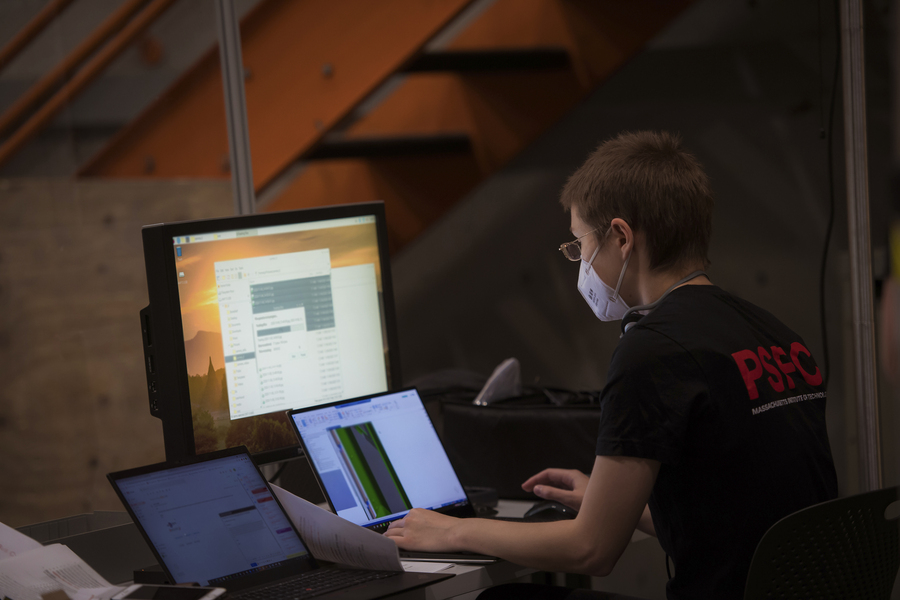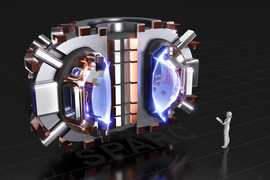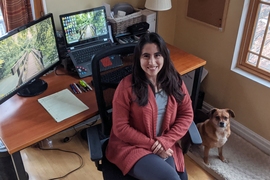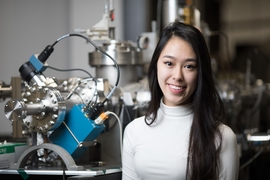“I love that we are doing something that no one else is doing.”
Amy Watterson is excited when she talks about SPARC, the pilot fusion plant being developed by MIT spinoff Commonwealth Fusion Systems (CSF). Since being hired as a mechanical engineer at the Plasma Science and Fusion Center (PSFC) two years ago, Watterson has found her skills stretching to accommodate the multiple needs of the project.
Fusion, which fuels the sun and stars, has long been sought as a carbon-free energy source for the world. For decades researchers have pursued the “tokamak,” a doughnut-shaped vacuum chamber where hot plasma can be contained by magnetic fields and heated to the point where fusion occurs. Sustaining the fusion reactions long enough to draw energy from them has been a challenge.
Watterson is intimately aware of this difficulty. Much of her life she has heard the quip, “Fusion is 50 years away and always will be.” The daughter of PSFC research scientist Catherine Fiore, who headed the PSFC’s Office of Environment, Safety and Health, and Reich Watterson, an optical engineer working at the center, she had watched her parents devote years to making fusion a reality. She determined before entering Rensselaer Polytechnic Institute that she could forgo any attempt to follow her parents into a field that might not produce results during her career.
Working on SPARC has changed her mindset. Taking advantage of a novel high-temperature superconducting tape, SPARC’s magnets will be compact while generating magnetic fields stronger than would be possible from other mid-sized tokamaks, and producing more fusion power. It suggests a high-field device that produces net fusion gain is not 50 years away. SPARC is scheduled to be begin operation in 2025.
An education in modeling
Watterson’s current excitement, and focus, is due to an approaching milestone for SPARC: a test of the Toroidal Field Model Coil (TFMC), a scaled prototype for the HTS magnets that will surround SPARC’s toroidal vacuum chamber. Its design and manufacture have been shaped by computer models and simulations. As part of a large research team, Waterson has received an education in modeling over the past two years.
Computer models move scientific experiments forward by allowing researchers to predict what will happen to an experiment — or its materials — if a parameter is changed. Modeling a component of the TFMC, for example, researchers can test how it is affected by varying amounts of current, different temperatures or different materials. With this information they can make choices that will improve the success of the experiment.
In preparation for the magnet testing, Watterson has modeled aspects of the cryogenic system that will circulate helium gas around the TFMC to keep it cold enough to remain superconducting. Taking into consideration the amount of cooling entering the system, the flow rate of the helium, the resistance created by valves and transfer lines and other parameters, she can model how much helium flow will be necessary to guarantee the magnet stays cold enough. Adjusting a parameter can make the difference between a magnet remaining superconducting and becoming overheated or even damaged.
Watterson and her teammates have also modeled pressures and stress on the inside of the TFMC. Pumping helium through the coil to cool it down will add 20 atmospheres of pressure, which could create a degree of flex in elements of the magnet that are welded down. Modeling can help determine how much pressure a weld can sustain.
“How thick does a weld need to be, and where should you put the weld so that it doesn’t break — that’s something you don’t want to leave until you’re finally assembling it,” says Watterson.
Modeling the behavior of helium is particularly challenging because its properties change significantly as the pressure and temperature change.
“A few degrees or a little pressure will affect the fluid's viscosity, density, thermal conductivity, and heat capacity,” says Watterson. “The flow has different pressures and temperatures at different places in the cryogenic loop. You end up with a set of equations that are very dependent on each other, which makes it a challenge to solve.”
Role model
Watterson notes that her modeling depends on the contributions of colleagues at the PSFC, and praises the collaborative spirit among researchers and engineers, a community that now feels like family. Her teammates have been her mentors. “I’ve learned so much more on the job in two years than I did in four years at school,” she says.
She realizes that having her mother as a role model in her own family has always made it easier for her to imagine becoming a scientist or engineer. Tracing her early passion for engineering to a middle school Lego robotics tournament, her eyes widen as she talks about the need for more female engineers, and the importance of encouraging girls to believe they are equal to the challenge.
“I want to be a role model and tell them ‘I'm a successful engineer, you can be too.’ Something I run into a lot is that little girls will say, ‘I can't be an engineer, I'm not cut out for that.’ And I say, ‘Well that's not true. Let me show you. If you can make this Lego robot, then you can be an engineer.’ And it turns out they usually can.”
Then, as if making an adjustment to one of her computer models, she continues.
“Actually, they always can.”










